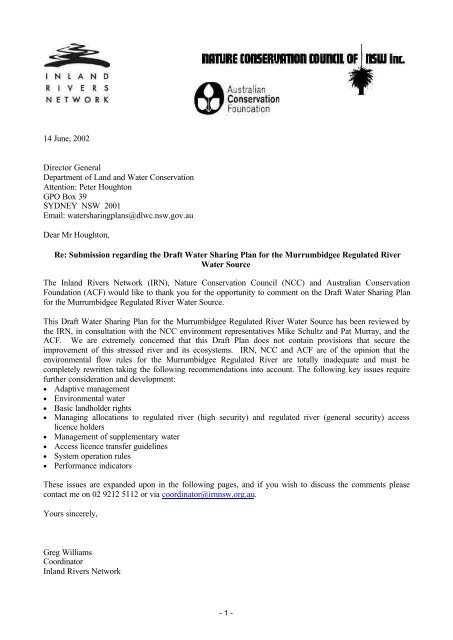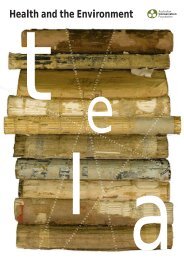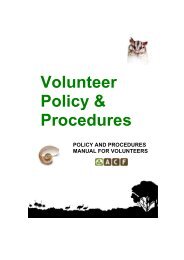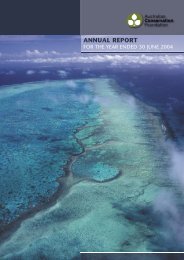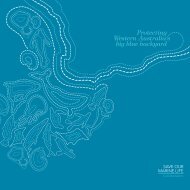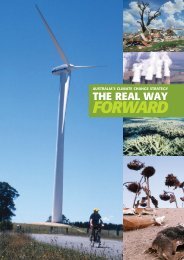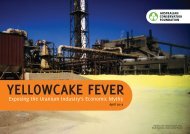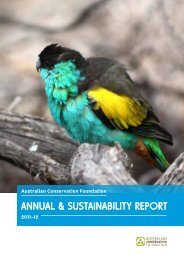Submission on Draft Water Sharing Plan for the Murrumbidgee River
Submission on Draft Water Sharing Plan for the Murrumbidgee River
Submission on Draft Water Sharing Plan for the Murrumbidgee River
You also want an ePaper? Increase the reach of your titles
YUMPU automatically turns print PDFs into web optimized ePapers that Google loves.
14 June, 2002<br />
Director General<br />
Department of Land and <strong>Water</strong> C<strong>on</strong>servati<strong>on</strong><br />
Attenti<strong>on</strong>: Peter Hought<strong>on</strong><br />
GPO Box 39<br />
SYDNEY NSW 2001<br />
Email: watersharingplans@dlwc.nsw.gov.au<br />
Dear Mr Hought<strong>on</strong>,<br />
Re: <str<strong>on</strong>g>Submissi<strong>on</strong></str<strong>on</strong>g> regarding <strong>the</strong> <strong>Draft</strong> <strong>Water</strong> <strong>Sharing</strong> <strong>Plan</strong> <strong>for</strong> <strong>the</strong> <strong>Murrumbidgee</strong> Regulated <strong>River</strong><br />
<strong>Water</strong> Source<br />
The Inland <strong>River</strong>s Network (IRN), Nature C<strong>on</strong>servati<strong>on</strong> Council (NCC) and Australian C<strong>on</strong>servati<strong>on</strong><br />
Foundati<strong>on</strong> (ACF) would like to thank you <strong>for</strong> <strong>the</strong> opportunity to comment <strong>on</strong> <strong>the</strong> <strong>Draft</strong> <strong>Water</strong> <strong>Sharing</strong> <strong>Plan</strong><br />
<strong>for</strong> <strong>the</strong> <strong>Murrumbidgee</strong> Regulated <strong>River</strong> <strong>Water</strong> Source.<br />
This <strong>Draft</strong> <strong>Water</strong> <strong>Sharing</strong> <strong>Plan</strong> <strong>for</strong> <strong>the</strong> <strong>Murrumbidgee</strong> Regulated <strong>River</strong> <strong>Water</strong> Source has been reviewed by<br />
<strong>the</strong> IRN, in c<strong>on</strong>sultati<strong>on</strong> with <strong>the</strong> NCC envir<strong>on</strong>ment representatives Mike Schultz and Pat Murray, and <strong>the</strong><br />
ACF. We are extremely c<strong>on</strong>cerned that this <strong>Draft</strong> <strong>Plan</strong> does not c<strong>on</strong>tain provisi<strong>on</strong>s that secure <strong>the</strong><br />
improvement of this stressed river and its ecosystems. IRN, NCC and ACF are of <strong>the</strong> opini<strong>on</strong> that <strong>the</strong><br />
envir<strong>on</strong>mental flow rules <strong>for</strong> <strong>the</strong> <strong>Murrumbidgee</strong> Regulated <strong>River</strong> are totally inadequate and must be<br />
completely rewritten taking <strong>the</strong> following recommendati<strong>on</strong>s into account. The following key issues require<br />
fur<strong>the</strong>r c<strong>on</strong>siderati<strong>on</strong> and development:<br />
• Adaptive management<br />
• Envir<strong>on</strong>mental water<br />
• Basic landholder rights<br />
• Managing allocati<strong>on</strong>s to regulated river (high security) and regulated river (general security) access<br />
licence holders<br />
• Management of supplementary water<br />
• Access licence transfer guidelines<br />
• System operati<strong>on</strong> rules<br />
• Per<strong>for</strong>mance indicators<br />
These issues are expanded up<strong>on</strong> in <strong>the</strong> following pages, and if you wish to discuss <strong>the</strong> comments please<br />
c<strong>on</strong>tact me <strong>on</strong> 02 9212 5112 or via coordinator@irnnsw.org.au.<br />
Yours sincerely,<br />
Greg Williams<br />
Coordinator<br />
Inland <strong>River</strong>s Network<br />
- 1 -
Inland <strong>River</strong>s Network and Nature C<strong>on</strong>servati<strong>on</strong> Council submissi<strong>on</strong>:<br />
<strong>Draft</strong> <strong>Water</strong> <strong>Sharing</strong> <strong>Plan</strong> <strong>for</strong> <strong>the</strong> <strong>Murrumbidgee</strong> Regulated <strong>River</strong> <strong>Water</strong> Source – 14 June 2002<br />
INTRODUCTION<br />
IRN, NCC and ACF recommendati<strong>on</strong>s <strong>for</strong> additi<strong>on</strong>al targets and word changes are listed below. We believe<br />
<strong>the</strong>y will enhance <strong>the</strong> scope of <strong>the</strong> clauses and <strong>the</strong>ir ability to achieve <strong>the</strong> ‘SMART’ objectives. Applying <strong>the</strong><br />
‘SMART’ principle is essential in developing an effective WSP. This means clauses are:<br />
• Specific<br />
− within <strong>the</strong> sphere of influence.<br />
− expressed in biophysical terms.<br />
• Measurable<br />
− clearly defined. For example, targets with percentages. Where qualitative words are used a definiti<strong>on</strong><br />
should accompany <strong>the</strong>m.<br />
− relative to an existing baseline or trend.<br />
• Achievable:<br />
− within <strong>the</strong> bounds of realistic resourcing, ensuring that m<strong>on</strong>itoring, capability and commitment are<br />
available.<br />
• Relevant<br />
− c<strong>on</strong>sistent with relevant legislati<strong>on</strong> and strategies.<br />
• Timebound<br />
− defined within a delivery date<br />
IRN, NCC and ACF recommend that where scientific knowledge is lacking, <strong>the</strong> Precauti<strong>on</strong>ary Principle<br />
should be applied to protect <strong>the</strong> water source and its dependent ecosystems. The development of adaptive<br />
Management systems and research to improve understanding of <strong>the</strong>se ecosystems is essential to <strong>the</strong>ir<br />
management.<br />
ADAPTIVE MANAGEMENT<br />
Inland rivers in New South Wales have often highly variable and unpredictable flows. Changes to flow<br />
patterns can have significant ecological effects that may not be noticed <strong>for</strong> many years or even decades.<br />
<strong>Water</strong> management needs to be sufficiently adaptive to <strong>the</strong>se natural and human induced changes, in order to<br />
maintain our rivers in an acceptable state <strong>for</strong> current and future generati<strong>on</strong>s.<br />
The 1994 Council of Australian Governments (CoAG) <strong>Water</strong> Re<strong>for</strong>ms Framework states that “…<br />
envir<strong>on</strong>mental requirements … be determined <strong>on</strong> <strong>the</strong> best available scientific in<strong>for</strong>mati<strong>on</strong> available”<br />
(Attachment A (4)(d)). The CoAG <strong>Water</strong> Re<strong>for</strong>ms Frameworks also states that “… jurisdicti<strong>on</strong>s would<br />
c<strong>on</strong>sider establishing envir<strong>on</strong>mental c<strong>on</strong>tingency allocati<strong>on</strong>s which provide <strong>for</strong> a review of <strong>the</strong> allocati<strong>on</strong>s<br />
five years after <strong>the</strong>y have been determined”. Basing envir<strong>on</strong>mental requirements <strong>on</strong> <strong>the</strong> best available<br />
scientific in<strong>for</strong>mati<strong>on</strong> and regular review of envir<strong>on</strong>mental flow provisi<strong>on</strong>s is essential <strong>for</strong> ensuring that <strong>the</strong><br />
<strong>Water</strong> Management Act 2000 objectives of protecting and restoring aquatic ecosystems are implemented.<br />
IRN, NCC and ACF are c<strong>on</strong>cerned that this <strong>Draft</strong> WSP does not c<strong>on</strong>tain adequate provisi<strong>on</strong>s <strong>for</strong> adaptive<br />
management. Secti<strong>on</strong> 42(2) of <strong>the</strong> <strong>Water</strong> Management Act 2000 allows WSPs to specify <strong>the</strong> circumstances<br />
by which a plan may be changed within its ten-year tenure, without attracting compensati<strong>on</strong> to entitlement<br />
holders. IRN, NCC and ACF believe that <strong>the</strong>re are a number of issues and processes relevant to <strong>the</strong><br />
<strong>Murrumbidgee</strong> Regulated <strong>River</strong> <strong>Water</strong> Source that will impact up<strong>on</strong> water sharing, and must be incorporated<br />
into <strong>the</strong> <strong>Plan</strong> as <strong>the</strong>y arise.<br />
In Part A Secti<strong>on</strong> 2, page 3 of <strong>the</strong> WSP guide it is stated that:<br />
“The <strong>Water</strong> <strong>Sharing</strong> <strong>Plan</strong> will become a statutory plan under <strong>the</strong> <strong>Water</strong> Management Act 2000<br />
and be in effect <strong>for</strong> a 10 year period, <strong>the</strong>reby providing security of access <strong>for</strong> envir<strong>on</strong>mental<br />
water and <strong>for</strong> all water users during its term. Fur<strong>the</strong>r to this, holders of water access licences<br />
will be able to claim compensati<strong>on</strong> if water access is reduced during <strong>the</strong> term of this plan, as a<br />
c<strong>on</strong>sequence of variati<strong>on</strong> to <strong>the</strong> bulk access regime established by <strong>the</strong> plan, <strong>for</strong> purposes not<br />
specified by this plan.” change made to <strong>the</strong> <strong>Plan</strong> during its term reduces <strong>the</strong> water available <strong>for</strong><br />
extracti<strong>on</strong>”.<br />
- 2 -
Inland <strong>River</strong>s Network and Nature C<strong>on</strong>servati<strong>on</strong> Council submissi<strong>on</strong>:<br />
<strong>Draft</strong> <strong>Water</strong> <strong>Sharing</strong> <strong>Plan</strong> <strong>for</strong> <strong>the</strong> <strong>Murrumbidgee</strong> Regulated <strong>River</strong> <strong>Water</strong> Source – 14 June 2002<br />
If it is shown that <strong>the</strong>re is not enough water allocated <strong>for</strong> <strong>the</strong> protecti<strong>on</strong> of <strong>the</strong> envir<strong>on</strong>ment, IRN, NCC and<br />
ACF believes <strong>the</strong>re must not be any compensati<strong>on</strong> due to <strong>the</strong> paucity of data regarding <strong>the</strong> nature of <strong>the</strong><br />
watercourses and flow patterns, as well as <strong>the</strong> nature of <strong>the</strong> requirements <strong>for</strong> <strong>the</strong> envir<strong>on</strong>ment.<br />
The WSP and <strong>the</strong> WSP Guide do not c<strong>on</strong>tain provisi<strong>on</strong> <strong>for</strong> flexibility in <strong>the</strong> face of possible reducti<strong>on</strong>s in<br />
available water, likely to arise from climate change or o<strong>the</strong>r catchment/landuse practices that may increase<br />
water use. Nor does it c<strong>on</strong>tain provisi<strong>on</strong>s <strong>for</strong> specified amendments relating to threatened species, flow<br />
provisi<strong>on</strong>s, envir<strong>on</strong>mental health water or <strong>the</strong> impact of a significant water quality incident.<br />
IRN, NCC and ACF are also c<strong>on</strong>cerned that flow rules to protect pools during <strong>the</strong> drier m<strong>on</strong>ths are not<br />
sufficiently adaptive. It is imperative that flows be adaptively managed within <strong>the</strong> ten year tenure of <strong>the</strong><br />
<strong>Water</strong> <strong>Sharing</strong> <strong>Plan</strong>s as provided <strong>for</strong> by <strong>the</strong> <strong>Water</strong> Management Act 2000 Secti<strong>on</strong> 5(2)(h).<br />
Adaptive management provisi<strong>on</strong>s have been included in WSPs prepared <strong>for</strong> groundwater and unregulated<br />
water sources, and <strong>the</strong> envir<strong>on</strong>ment groups can see no reas<strong>on</strong> why <strong>the</strong>y should not apply to regulated systems<br />
such as <strong>the</strong> <strong>Murrumbidgee</strong> <strong>River</strong>. Fur<strong>the</strong>r, Clause 4 of <strong>the</strong> 1994 CoAG framework requires an adaptive<br />
management approach.<br />
Recommendati<strong>on</strong>s<br />
IRN, NCC and ACF recommend that:<br />
• Provisi<strong>on</strong>s <strong>for</strong> flexibility under Secti<strong>on</strong> 42(2) of <strong>the</strong> <strong>Water</strong> Management Act 2000 are allowed <strong>for</strong> in <strong>the</strong><br />
<strong>Murrumbidgee</strong> Regulated <strong>River</strong> WSP without attracting <strong>the</strong> need <strong>for</strong> compensati<strong>on</strong> in <strong>the</strong> following<br />
circumstances:<br />
− <strong>the</strong> Murray interstate flows process.<br />
− <strong>the</strong> needs of Ramsar listed wetlands and wetlands of nati<strong>on</strong>al importance.<br />
− changes in water source hydrology as a result of catchment land use changes or climatic changes.<br />
− provisi<strong>on</strong>s <strong>for</strong> specified amendments relating to key threatening processes; threatened species recovery<br />
and threat abatement plans threatened species (in particular <strong>the</strong> Trout Cod recovery plan).<br />
− provisi<strong>on</strong>s <strong>for</strong> specified amendments relating to envir<strong>on</strong>mental health water or <strong>the</strong> impact of a<br />
significant water quality incident (such as salinity or blue-green-algae blooms).<br />
− m<strong>on</strong>itoring and research programs (such as IMEF)<br />
− exercise of native title rights to water allocati<strong>on</strong>s <strong>for</strong> indigenous purposes.<br />
− future in<strong>for</strong>mati<strong>on</strong> about <strong>the</strong> social and ec<strong>on</strong>omic impacts of changing envir<strong>on</strong>mental c<strong>on</strong>diti<strong>on</strong>s.<br />
• Flows are adaptively managed within <strong>the</strong> ten-year tenure of <strong>the</strong> <strong>Water</strong> <strong>Sharing</strong> <strong>Plan</strong>s as provided <strong>for</strong> by<br />
<strong>the</strong> <strong>Water</strong> Management Act 2000 Secti<strong>on</strong> 5(2)(h) without attracting <strong>the</strong> need <strong>for</strong> compensati<strong>on</strong>.<br />
ENVIRONMENTAL WATER<br />
It is generally acknowledged by freshwater ecologists that water is <strong>the</strong> most critical comp<strong>on</strong>ent of healthy<br />
riverine ecosystems. The IRN, NCC and ACF is c<strong>on</strong>cerned that in spite of <strong>the</strong> extensive process of<br />
community c<strong>on</strong>sultati<strong>on</strong>, <strong>the</strong>re still appears to be a fundamental lack of understanding about <strong>the</strong> role of water<br />
in maintaining healthy riverine ecosystems. This is reflected in some of <strong>the</strong> recommendati<strong>on</strong>s from <strong>the</strong><br />
<strong>Murrumbidgee</strong> Regulated <strong>River</strong> Management Committee in <strong>the</strong> <strong>Draft</strong> WSP <strong>for</strong> <strong>the</strong> <strong>Murrumbidgee</strong> Regulated<br />
<strong>River</strong> <strong>Water</strong> Source.<br />
All ecosystems require an input of energy to functi<strong>on</strong>. Land-based ecosystems derive this energy directly<br />
from <strong>the</strong> Sun through <strong>the</strong> process of photosyn<strong>the</strong>sis. <strong>River</strong>s however, particularly those in <strong>the</strong> upper<br />
catchment, do not have enough green plants within <strong>the</strong>m to supply sufficient energy <strong>for</strong> <strong>the</strong> requirements of<br />
aquatic animals (fish, yabbies, mudeyes, etc.). <strong>River</strong>s <strong>the</strong>re<strong>for</strong>e have to rely <strong>on</strong> inputs of organic material in<br />
<strong>the</strong> <strong>for</strong>m of leaves, bark, twigs and branches, from <strong>the</strong>ir riparian and floodplain z<strong>on</strong>es. Some of this material<br />
ei<strong>the</strong>r falls into <strong>the</strong> river or is blown in. Most however is carried in by medium to high flows (lateral or<br />
floodplain c<strong>on</strong>nectivity). Macroinvertebrates process this material, and <strong>the</strong>y in turn, are eaten by fish. This<br />
is <strong>the</strong> most important reas<strong>on</strong> behind <strong>the</strong> EPA’s <strong>River</strong> Flow Objectives 3-7. (<strong>River</strong> Flow Objectives 1-2<br />
ensures that aquatic life survives dry periods and droughts).<br />
- 3 -
Inland <strong>River</strong>s Network and Nature C<strong>on</strong>servati<strong>on</strong> Council submissi<strong>on</strong>:<br />
<strong>Draft</strong> <strong>Water</strong> <strong>Sharing</strong> <strong>Plan</strong> <strong>for</strong> <strong>the</strong> <strong>Murrumbidgee</strong> Regulated <strong>River</strong> <strong>Water</strong> Source – 14 June 2002<br />
O<strong>the</strong>r benefits that medium and high flows bring, are that <strong>the</strong>y provide critical cues <strong>for</strong> fish and col<strong>on</strong>ial<br />
waterbird breeding events, and are important in <strong>the</strong> diluti<strong>on</strong> of toxicants such as salt and blue-green algae.<br />
The CRC <strong>for</strong> Freshwater Ecology draws <strong>the</strong> analogy that <strong>the</strong> riparian and floodplain z<strong>on</strong>es of a river are<br />
equivalent to <strong>the</strong> bark surrounding <strong>the</strong> woody material of a tree. There<strong>for</strong>e harvesting high flows is like<br />
ringbarking a river.<br />
<strong>Water</strong> levels in natural river pools should be protected during periods of no flow (<strong>River</strong> Flow Objectives 1-<br />
2). During dry times some streams stop flowing and <strong>for</strong>m pools that are refuges <strong>for</strong> aquatic plants and<br />
animals. Pumping water from <strong>the</strong>se areas can make it more difficult <strong>for</strong> many species to recover after a<br />
drought. We have included some additi<strong>on</strong>al recommendati<strong>on</strong>s in this submissi<strong>on</strong> which will go fur<strong>the</strong>r in<br />
protecting low flows, and help ensure that fish passage and pools are protected.<br />
<strong>Water</strong> Management Principles in <strong>the</strong> Act that are particularly relevant to envir<strong>on</strong>mental flow provisi<strong>on</strong>s in<br />
water sharing plans include; protecting and restoring water sources, floodplains and dependent ecosystems<br />
(including wetlands), protecting habitats, animals and plants which benefit from water, protecting water<br />
quality, minimising cumulative impacts, and applying <strong>the</strong> principles of adaptive management. <strong>Plan</strong>s can be<br />
changed or amended by a Minister’s plan under Secti<strong>on</strong> 42(2) of <strong>the</strong> Act if in <strong>the</strong> public interest or if<br />
specified within <strong>the</strong> plan. It is evident that <strong>the</strong>re is a flagrant disregard <strong>for</strong> <strong>the</strong> <strong>Water</strong> Management Principles<br />
in <strong>the</strong> <strong>Draft</strong> WSP <strong>for</strong> <strong>the</strong> <strong>Murrumbidgee</strong> Regulated <strong>River</strong> <strong>Water</strong> Source.<br />
Most of <strong>the</strong> rules in <strong>the</strong> <strong>Draft</strong> <strong>Plan</strong> <strong>for</strong> <strong>the</strong> provisi<strong>on</strong> of envir<strong>on</strong>mental water are made “c<strong>on</strong>tingent <strong>on</strong> supplies<br />
to water users and are generally tied to <strong>the</strong> resource availability <strong>for</strong> water users ra<strong>the</strong>r than envir<strong>on</strong>mental<br />
needs. There also does not appear to be any clearly defined envir<strong>on</strong>mental management objectives <strong>for</strong> <strong>the</strong><br />
various envir<strong>on</strong>mental water accounts and <strong>the</strong> draft plan does not specify <strong>the</strong> triggers and rules <strong>for</strong> <strong>the</strong> release<br />
of this water <strong>for</strong> envir<strong>on</strong>mental purposes” ((Part B, p. 11).<br />
The following table (Table 1), prepared by Professor Gary J<strong>on</strong>es from <strong>the</strong> CRC <strong>for</strong> Freshwater Ecology,<br />
indicates <strong>the</strong> percentage of natural flow required to sustain a healthy working river.<br />
Table 1: Percentage of Natural Flow Required to Sustain a Healthy Working <strong>River</strong><br />
% of Natural Flow (<strong>for</strong><br />
critical indicators)<br />
Greater than two-thirds<br />
Greater than half<br />
Less than half<br />
Probability of having a<br />
healthy working river<br />
HIGH<br />
MODERATE<br />
LOW<br />
Reference: J<strong>on</strong>es, G. 2002 Setting envir<strong>on</strong>mental flows to sustain a healthy working river. <strong>Water</strong>shed<br />
February: 1-2.<br />
Scientific evidence indicates that <strong>the</strong> current flow regimes in NSW are not sufficient to achieve <strong>the</strong> principle<br />
of Ecologically Sustainable Development nor to “protect, enhance and restore water sources, <strong>the</strong>ir associated<br />
ecosystems, ecological processes, biological diversity and <strong>the</strong>ir water quality” (NSW <strong>Water</strong> Management Act<br />
2000 Secti<strong>on</strong> 3 Objects (a) &(b)).<br />
Our primary c<strong>on</strong>cern is that <strong>the</strong> <strong>Draft</strong> WSP <strong>for</strong> <strong>the</strong> <strong>Murrumbidgee</strong> Regulated <strong>River</strong> <strong>Water</strong> Source is that it<br />
has not been developed in a manner that is c<strong>on</strong>sistent with <strong>the</strong> Act. The envir<strong>on</strong>ment has not been prioritised<br />
as per Secti<strong>on</strong> 5(3) & 9(b) of <strong>the</strong> Act, and <strong>the</strong> plan is not c<strong>on</strong>sistent with <strong>the</strong> State <strong>Water</strong> Management<br />
Outcomes <strong>Plan</strong> (SWMOP) as per Secti<strong>on</strong> 9. Under <strong>the</strong> <strong>Water</strong> Management Act <strong>the</strong> WSP is to determine <strong>the</strong><br />
envir<strong>on</strong>ment’s adequate share of rivers as first priority, basic landholder rights sec<strong>on</strong>d, and <strong>the</strong> extractive<br />
regime last.<br />
As it stands now, <strong>the</strong> <strong>Draft</strong> WSP <strong>for</strong> <strong>the</strong> <strong>Murrumbidgee</strong> Regulated <strong>River</strong> <strong>Water</strong> Source:<br />
- 4 -
Inland <strong>River</strong>s Network and Nature C<strong>on</strong>servati<strong>on</strong> Council submissi<strong>on</strong>:<br />
<strong>Draft</strong> <strong>Water</strong> <strong>Sharing</strong> <strong>Plan</strong> <strong>for</strong> <strong>the</strong> <strong>Murrumbidgee</strong> Regulated <strong>River</strong> <strong>Water</strong> Source – 14 June 2002<br />
• Envir<strong>on</strong>mental water is c<strong>on</strong>tingent <strong>on</strong> irrigati<strong>on</strong> allocati<strong>on</strong> requirements and as such compromises <strong>the</strong><br />
protecti<strong>on</strong> and restorati<strong>on</strong> of <strong>the</strong> river’s ecological processes, its dependent ecosystems and native species.<br />
• Has no secure envir<strong>on</strong>mental water o<strong>the</strong>r than that <strong>for</strong> <strong>the</strong> maintenance of minimum flows.<br />
Envir<strong>on</strong>mental C<strong>on</strong>tingency/Health Allowance water is incorporated in <strong>the</strong> WSP as Class B<br />
Supplementary Envir<strong>on</strong>mental <strong>Water</strong>.<br />
• Has no methodology <strong>for</strong> managed envir<strong>on</strong>mental releases from stored water.<br />
• Stands in isolati<strong>on</strong> from <strong>the</strong> WSP’s of unregulated catchments, in particular Tarcutta Creek WSP, and<br />
identifies no envir<strong>on</strong>mental relati<strong>on</strong>ships.<br />
• Does not identify <strong>the</strong> ecological values that <strong>the</strong> <strong>Plan</strong> is to protect<br />
Minister’s Note: (Part B, p.11)<br />
IRN, NCC and ACF fully c<strong>on</strong>cur with <strong>the</strong> Minister’s Note <strong>on</strong> p.11 of Part B. The envir<strong>on</strong>mental flow rules,<br />
as <strong>the</strong>y stand in this <strong>Draft</strong> WSP, are extremely complex to <strong>the</strong> point that <strong>the</strong>y are virtually impossible to<br />
understand, review and identify <strong>the</strong>ir intended or likely outcomes. It would seem that <strong>the</strong> intent of this<br />
complexity is to reinstate <strong>the</strong> status quo and entrench <strong>the</strong> highly inappropriate irrigati<strong>on</strong> practices of <strong>the</strong> last<br />
30 years – which have led to this river being classified as ‘stressed’.<br />
The scientific evidence <strong>for</strong> this, as compiled in <strong>the</strong> report “The <strong>Murrumbidgee</strong>: assessing <strong>the</strong> ‘health’ of a<br />
working river”, jointly commissi<strong>on</strong>ed by <strong>the</strong> Agribusiness Task<strong>for</strong>ce, DLWC, <strong>the</strong> EPA and included several<br />
members of <strong>the</strong> irrigati<strong>on</strong> community, is unequivocal. It is <strong>the</strong>se practices that have led to <strong>the</strong> <strong>Murrumbidgee</strong><br />
<strong>River</strong> being brought to <strong>the</strong> brink of becoming an ecological basket case. The recent listing of <strong>the</strong> aquatic<br />
ecological community in <strong>the</strong> natural drainage system of <strong>the</strong> lower Murray <strong>River</strong> catchment as an endangered<br />
ecological community under <strong>the</strong> Fisheries Management Act 1994 is fur<strong>the</strong>r evidence of <strong>the</strong> desperate state of<br />
this river.<br />
Not <strong>on</strong>ly do <strong>the</strong> dissenting reports cast doubt about <strong>the</strong> ability of <strong>the</strong> proposed rules to maintain or improve<br />
<strong>the</strong> ecological health of <strong>the</strong> <strong>Murrumbidgee</strong> <strong>River</strong>, but <strong>the</strong> WSP also c<strong>on</strong>cedes as much. Table 1, Part A of<br />
<strong>the</strong> <strong>Plan</strong> indicates that <strong>the</strong> envir<strong>on</strong>mental provisi<strong>on</strong>s will <strong>on</strong>ly make a marginal improvement to flow<br />
c<strong>on</strong>diti<strong>on</strong>s compared to <strong>the</strong>1993/94 c<strong>on</strong>diti<strong>on</strong>s under <strong>the</strong> Murray-Darling Basin cap <strong>on</strong> water diversi<strong>on</strong>s.<br />
Minister’s Note: (Part B, p.9)<br />
The Minister’s Note <strong>on</strong> p.9 of Part B also correctly identifies, according to our envir<strong>on</strong>ment representatives,<br />
that <strong>the</strong> envir<strong>on</strong>mental water rules are overly focussed <strong>on</strong> providing flows to wetlands in <strong>the</strong> middle reaches<br />
of <strong>the</strong> <strong>Murrumbidgee</strong> <strong>River</strong>. There are significant wetlands <strong>on</strong> <strong>the</strong> lower floodplain of <strong>the</strong> river, notably <strong>the</strong><br />
Lowbidgee wetlands, which are not targeted and which presently receive a greatly reduced water supply.<br />
Changing <strong>Water</strong> Regimes and Wetland Habitat <strong>on</strong> <strong>the</strong> Lower <strong>Murrumbidgee</strong> Floodplain of <strong>the</strong><br />
<strong>Murrumbidgee</strong> <strong>River</strong> (Kings<strong>for</strong>d, R.T. and Thomas, R.F., 2001) documents how over 140 years of water<br />
resource development at a catchment and local scale has resulted in <strong>the</strong> disappearance or degradati<strong>on</strong> of at<br />
least 76% of <strong>the</strong> wetlands. In 1998/99 95% of diverted water reduced <strong>the</strong> amount of water reaching <strong>the</strong><br />
Lower <strong>Murrumbidgee</strong> floodplain by at least 60%. ‘Development’ of <strong>the</strong> water resource has not been evenly<br />
spread out over <strong>the</strong> 140 years. Kings<strong>for</strong>d and Thomas estimate that 26% of <strong>the</strong> floodplain was lost in <strong>the</strong><br />
period up to 1975. Over <strong>the</strong> next 23 years from 1975 to 1998 an additi<strong>on</strong>al 32% of <strong>the</strong> original wetland was<br />
lost. Of <strong>the</strong> remaining 42% of original wetland area in <strong>the</strong> Lower <strong>Murrumbidgee</strong> floodplain, 44% of <strong>the</strong><br />
perennial flood dependent vegetati<strong>on</strong> was in poor health or dead and defined as ‘degraded’.<br />
<strong>Water</strong> <strong>for</strong> o<strong>the</strong>r ecological requirements has also not been explicitly addressed by <strong>the</strong> plan. Fur<strong>the</strong>rmore, <strong>the</strong><br />
mimicking of natural flow variability below Burrinjuck Dam achieved by <strong>the</strong> 1998 rules is not fully<br />
maintained.<br />
Recommendati<strong>on</strong>s<br />
IRN, NCC and ACF are of <strong>the</strong> opini<strong>on</strong> that <strong>the</strong> envir<strong>on</strong>mental flow rules <strong>for</strong> <strong>the</strong> <strong>Murrumbidgee</strong><br />
Regulated <strong>River</strong> are totally inadequate and must be completely rewritten taking <strong>the</strong> following<br />
recommendati<strong>on</strong>s into account.<br />
- 5 -
Inland <strong>River</strong>s Network and Nature C<strong>on</strong>servati<strong>on</strong> Council submissi<strong>on</strong>:<br />
<strong>Draft</strong> <strong>Water</strong> <strong>Sharing</strong> <strong>Plan</strong> <strong>for</strong> <strong>the</strong> <strong>Murrumbidgee</strong> Regulated <strong>River</strong> <strong>Water</strong> Source – 14 June 2002<br />
• The current Supplementary Envir<strong>on</strong>mental <strong>Water</strong> must be changed to Class A Envir<strong>on</strong>mental Health<br />
<strong>Water</strong> (EHW), so that this water is assured <strong>for</strong> envir<strong>on</strong>mental purposes and in no way c<strong>on</strong>tingent up<strong>on</strong><br />
irrigati<strong>on</strong> allocati<strong>on</strong>s. EHW stored <strong>for</strong> managed release should be increased to 100 gigalitres (GL) per<br />
year, which is c<strong>on</strong>sidered by envir<strong>on</strong>ment groups to be <strong>the</strong> minimum amount required to maintain <strong>the</strong><br />
health of <strong>the</strong> river and its wetlands.<br />
The groups envisage that <strong>the</strong> 100GL EHW volume would not necessarily have to be released each year,<br />
but should be able to be stored, and released c<strong>on</strong>tingent up<strong>on</strong> envir<strong>on</strong>mental triggers. There is significant<br />
ecological benefit in releasing some water following a natural ‘fresh’, with fur<strong>the</strong>r releases after two<br />
weeks depending up<strong>on</strong> tributary flows. A regime such as this will ensure wetlands are adequately<br />
inundated fur<strong>the</strong>r downstream.<br />
• An envir<strong>on</strong>mental flow sub-committee should be <strong>for</strong>med to oversee <strong>the</strong> management of envir<strong>on</strong>mental<br />
water. This could include representatives from local envir<strong>on</strong>ment groups (such as <strong>the</strong> REC), DLWC,<br />
EPA, NPWS, State Forests, scientists and indigenous interests. They would c<strong>on</strong>sider tributary inflows in<br />
deciding <strong>on</strong> <strong>the</strong> timing and volume of water released and incorporate triggers and protocols <strong>for</strong> managed<br />
releases ensuring adequate envir<strong>on</strong>mental water. This could be included as an additi<strong>on</strong>al Schedule 9 to<br />
Part B of <strong>the</strong> <strong>Draft</strong> WSP.<br />
• Translucent release rules in <strong>the</strong> <strong>Draft</strong> WSP <strong>on</strong>ly apply to <strong>the</strong> area below Burrinjuck Dam to <strong>the</strong><br />
c<strong>on</strong>fluence of <strong>the</strong> Tumut <strong>River</strong>. The envir<strong>on</strong>ment groups believe that new translucent rules need to be<br />
developed which are simpler and have dam release triggers that are envir<strong>on</strong>mentally and hydrologically<br />
sound.<br />
• The <strong>Draft</strong> WSP has not put in place appropriate targets to provide <strong>for</strong> <strong>the</strong> recovery of threatened species,<br />
populati<strong>on</strong>s and communities and <strong>the</strong>ir future removal from threatened species listing. The objective to<br />
promote threatened species recovery is c<strong>on</strong>diti<strong>on</strong>al in <strong>the</strong> <strong>Draft</strong> WSP, and <strong>the</strong>re is a low probability that<br />
this will prevent <strong>the</strong> c<strong>on</strong>tinued decline of populati<strong>on</strong>s. The envir<strong>on</strong>ment groups recommend that Part B of<br />
<strong>the</strong> <strong>Water</strong> <strong>Sharing</strong> <strong>Plan</strong> include a schedule of threatened species and facilitate implementati<strong>on</strong> of threat<br />
abatement plans and recovery plans where <strong>the</strong>se species occur. Recovery <strong>Plan</strong>s must be produced<br />
pursuant to <strong>the</strong> Fisheries Management Act 1994 within three years of gazettal and <strong>the</strong> WSP should be<br />
amended to be c<strong>on</strong>sistent with recommendati<strong>on</strong>s made <strong>the</strong>rein. The envir<strong>on</strong>ment groups recommend that<br />
<strong>the</strong> <strong>Draft</strong> WSP acknowledge Key Threatening Processes and reduce or ameliorate <strong>the</strong>se impacts.<br />
• Schedule 8 flows, which determine when water is diverted into <strong>the</strong> Lowbidgee Floodplain District are<br />
totally inadequate in <strong>the</strong> <strong>Draft</strong> WSP and do not account <strong>for</strong>, or protect envir<strong>on</strong>mental water. Fur<strong>the</strong>r, <strong>the</strong><br />
seas<strong>on</strong>ality required <strong>for</strong> ecosystem functi<strong>on</strong> is not c<strong>on</strong>sidered. IRN, NCC and ACF recommend that<br />
Schedule 8 flows in this WSP <strong>for</strong> <strong>the</strong> <strong>Murrumbidgee</strong> Regulated <strong>River</strong> <strong>Water</strong> Source must make provisi<strong>on</strong><br />
<strong>for</strong> envir<strong>on</strong>mental water flows and its seas<strong>on</strong>ality into <strong>the</strong> Lowbidgee Floodplain Districts.<br />
• An envir<strong>on</strong>mental flow sub-committee should be <strong>for</strong>med to oversee <strong>the</strong> development of a water<br />
management plan <strong>for</strong> <strong>the</strong> Lowbidgee Floodplain Districts. This could include representatives from local<br />
envir<strong>on</strong>ment groups (such as <strong>the</strong> REC), DLWC, EPA, NPWS, State Forests, scientists and indigenous<br />
interests of envir<strong>on</strong>mental water.<br />
• The <strong>Draft</strong> WSP has not established adequate flow rules and extracti<strong>on</strong> limits in relati<strong>on</strong> to interim targets<br />
2 and 4 of <strong>the</strong> <strong>Draft</strong> State <strong>Water</strong> Management Outcomes <strong>Plan</strong>. The WSP must be c<strong>on</strong>sistent with <strong>the</strong>se<br />
requirements.<br />
BASIC LANDHOLDER RIGHTS<br />
Native title rights<br />
Advice No. 14 to <strong>Water</strong> Management Committees outlines <strong>the</strong> Committee’s role with respect to Aboriginal<br />
issues and cultural heritage protecti<strong>on</strong>. The Committee’s role is to identify Aboriginal cultural and heritage<br />
values and provide recommendati<strong>on</strong>s <strong>on</strong> how to protect <strong>the</strong>se in <strong>the</strong>ir area as far as <strong>the</strong>y relate to water<br />
sharing. There<strong>for</strong>e <strong>the</strong> plan must include:<br />
- 6 -
Inland <strong>River</strong>s Network and Nature C<strong>on</strong>servati<strong>on</strong> Council submissi<strong>on</strong>:<br />
<strong>Draft</strong> <strong>Water</strong> <strong>Sharing</strong> <strong>Plan</strong> <strong>for</strong> <strong>the</strong> <strong>Murrumbidgee</strong> Regulated <strong>River</strong> <strong>Water</strong> Source – 14 June 2002<br />
• c<strong>on</strong>siderati<strong>on</strong> of <strong>the</strong> Aboriginal Heritage In<strong>for</strong>mati<strong>on</strong> System register of sites and Aboriginal places.<br />
• habitat requirements <strong>for</strong> totemic and o<strong>the</strong>r culturally important species, including threatened species in<br />
<strong>the</strong> water management area.<br />
• c<strong>on</strong>siderati<strong>on</strong> of c<strong>on</strong>temporary Aboriginal needs and uses of water and related water resources.<br />
Whilst IRN, NCC and ACF are in full support of water allocati<strong>on</strong>s <strong>for</strong> indigenous purposes, we str<strong>on</strong>gly<br />
oppose such water being taken from <strong>the</strong> envir<strong>on</strong>ment. As such we believe that Part 5 ‘Basic landholder<br />
rights’, and specifically Clauses 27, 28 and 31, [a <strong>for</strong>matting error exists at this point as Clause 29 and 30 are<br />
not included] need to be streng<strong>the</strong>ned in terms of <strong>the</strong>ir treatment of native title rights.<br />
Recommendati<strong>on</strong>s<br />
IRN, NCC and ACF recommend that:<br />
• The following clauses be included after Clause 31:<br />
− “A native title holder in relati<strong>on</strong> to waters of <strong>the</strong> water source is entitled, under <strong>the</strong> provisi<strong>on</strong> of<br />
Secti<strong>on</strong> 55 of <strong>the</strong> Act, to take and use water in <strong>the</strong> exercise of native title rights.”<br />
− “Should native title rights that extend bey<strong>on</strong>d those which are provided <strong>for</strong> in <strong>the</strong> <strong>Water</strong> Management<br />
Act 2000, or in this <strong>Water</strong> <strong>Sharing</strong> <strong>Plan</strong>, be found to exist in a court of law, this plan will be reviewed<br />
and amended accordingly under Secti<strong>on</strong> 42(2) of <strong>the</strong> <strong>Water</strong> Management Act 2000.”<br />
− “At <strong>the</strong> commencement of <strong>the</strong> <strong>Plan</strong> no native title rights have been granted <strong>for</strong> <strong>the</strong> <strong>Murrumbidgee</strong><br />
Regulated <strong>River</strong> <strong>Water</strong> Source”<br />
− “The <strong>Plan</strong> recognises that <strong>the</strong> exercise of native title rights, as defined in Secti<strong>on</strong> 55 of <strong>the</strong> Act, may<br />
increase during <strong>the</strong> term of this <strong>Plan</strong>”<br />
− “Any granting of water allocati<strong>on</strong>s under native title rights must be allocated from <strong>the</strong> BEV <strong>for</strong> each<br />
flow class and cannot impact up<strong>on</strong> <strong>the</strong> agreed EHW allocati<strong>on</strong>s”.<br />
• Evidence should also be provided of having c<strong>on</strong>sidered <strong>the</strong> Aboriginal Heritage In<strong>for</strong>mati<strong>on</strong> System<br />
register of sites and Aboriginal places, or <strong>the</strong> habitat requirements <strong>for</strong> totemic and o<strong>the</strong>r culturally<br />
important species, including threatened species in <strong>the</strong> water management area.<br />
MANAGING ALLOCATIONS TO REGULATED RIVER (HIGH SECURITY) AND REGULATED<br />
RIVER (GENERAL SECURITY) ACCESS LICENCE HOLDERS<br />
Minister’s Note: (Part B, p.19)<br />
IRN, NCC and ACF support <strong>the</strong> CoAG c<strong>on</strong>cept of water trading which is that water should be used “to<br />
maximise its c<strong>on</strong>tributi<strong>on</strong> to nati<strong>on</strong>al income and welfare, within <strong>the</strong> social, physical, and ecological<br />
c<strong>on</strong>straints of catchments” (1994 CoAG Agreement, Clause 5[a]). We believe that this facilitates <strong>the</strong> flow of<br />
water to <strong>the</strong> highest value uses where <strong>the</strong>re are greater incentives to c<strong>on</strong>serve water.<br />
As such, we oppose Clause 75(h), which places a c<strong>on</strong>straint <strong>on</strong> temporary trade of water through <strong>the</strong> <strong>for</strong>feit<br />
of carryover and access to supplementary water.<br />
Recommendati<strong>on</strong><br />
IRN, NCC and ACF recommend that:<br />
• Clause 75(h), which places a c<strong>on</strong>straint <strong>on</strong> temporary trade of water through <strong>the</strong> <strong>for</strong>feit of carryover and<br />
access to supplementary water, is removed from <strong>the</strong> <strong>Water</strong> <strong>Sharing</strong> <strong>Plan</strong> <strong>for</strong> <strong>the</strong> <strong>Murrumbidgee</strong> Regulated<br />
<strong>River</strong> <strong>Water</strong> Source.<br />
MANAGEMENT OF SUPPLEMENTARY WATER<br />
Minister’s Note: (Part B, p.22)<br />
IRN, NCC and ACF agrees with <strong>the</strong> Minister’s Note Part B, p.22 that unregulated flows emanating from<br />
tributaries or dam spills are potentially very important <strong>for</strong> <strong>the</strong> ecological functi<strong>on</strong>ing of <strong>the</strong> river system.<br />
These flows significantly impact <strong>on</strong> <strong>the</strong> envir<strong>on</strong>mental benefit of natural ‘freshes’ and dam spills, and should<br />
be omitted from <strong>the</strong> <strong>Draft</strong> WSP. These licences have been cancelled in <strong>the</strong> past and we see no reas<strong>on</strong> why<br />
<strong>the</strong>y should be c<strong>on</strong>sidered again. Extracti<strong>on</strong> from ‘freshes’ and spills will also diminish <strong>the</strong> effectiveness of<br />
stored envir<strong>on</strong>mental releases throughout <strong>the</strong> river system, particularly in <strong>the</strong> lower reaches.<br />
- 7 -
Inland <strong>River</strong>s Network and Nature C<strong>on</strong>servati<strong>on</strong> Council submissi<strong>on</strong>:<br />
<strong>Draft</strong> <strong>Water</strong> <strong>Sharing</strong> <strong>Plan</strong> <strong>for</strong> <strong>the</strong> <strong>Murrumbidgee</strong> Regulated <strong>River</strong> <strong>Water</strong> Source – 14 June 2002<br />
This note also menti<strong>on</strong>s that <strong>the</strong>y are important to many users in <strong>the</strong> water source as additi<strong>on</strong>al supply. The<br />
draft plan proposes to c<strong>on</strong>tinue to allow water users access to <strong>the</strong>se flows.<br />
As far as <strong>the</strong> IRN, NCC and ACF are c<strong>on</strong>cerned, <strong>the</strong> priorities of <strong>the</strong> Act clearly determines how this water<br />
should be allocated. Under <strong>the</strong> <strong>Water</strong> Management Act 2000 <strong>the</strong> WSP is to determine <strong>the</strong> envir<strong>on</strong>ment’s<br />
adequate share of rivers as first priority, basic landholder rights sec<strong>on</strong>d, and <strong>the</strong> extractive regime last. We<br />
object to <strong>the</strong> reinstatement of Supplementary Access Licences (SALs) and str<strong>on</strong>gly recommend that <strong>the</strong>y be<br />
removed from <strong>the</strong> WSP.<br />
Recommendati<strong>on</strong>s<br />
IRN, NCC and ACF str<strong>on</strong>gly recommend that:<br />
• Supplementary Access Licences (SALs) be removed from <strong>the</strong> <strong>Water</strong> <strong>Sharing</strong> <strong>Plan</strong> <strong>for</strong> <strong>the</strong> <strong>Murrumbidgee</strong><br />
Regulated <strong>River</strong> <strong>Water</strong> Source. 1<br />
ACCESS LICENCE TRANSFER GUIDELINES<br />
IRN, NCC and ACF are c<strong>on</strong>cerned that losses due to seepage and evaporati<strong>on</strong> will be omitted from <strong>the</strong> total<br />
water transfer amount, and be borne by <strong>the</strong> envir<strong>on</strong>ment. Part 13 Access Licenses Transfer Guidelines of <strong>the</strong><br />
WSP are not clear about allocati<strong>on</strong> of water lost through <strong>the</strong> transfer of water allocati<strong>on</strong>s. The <strong>Draft</strong><br />
SWMOP defines <strong>the</strong> ‘extracti<strong>on</strong> limit’ in <strong>the</strong> glossary as:<br />
A limit <strong>on</strong> <strong>the</strong> amount of water that can be taken from a river <strong>for</strong> licensed purposes and includes<br />
both <strong>the</strong> water pumped directly from <strong>the</strong> river or aquifer as well as those volumes diverted from<br />
<strong>the</strong> rivers via irrigati<strong>on</strong> or o<strong>the</strong>r channel measured at <strong>the</strong> offtake point, and <strong>the</strong>re<strong>for</strong>e includes<br />
<strong>the</strong> transmissi<strong>on</strong> loses associated with those diversi<strong>on</strong>s.<br />
Part 13 Access Licenses Transfer Guidelines are not clear about assessing <strong>the</strong> envir<strong>on</strong>mental impact of water<br />
trading within <strong>the</strong> Diversi<strong>on</strong> Management Unit. Trade in water, up or downstream, and between various<br />
water sources can have a range of envir<strong>on</strong>mental c<strong>on</strong>sequences which should be investigated and assessed<br />
prior to trades taking place.<br />
Recommendati<strong>on</strong>s<br />
IRN, NCC and ACF recommend that:<br />
• The following Clause should be inserted after Clause 96:<br />
“The transfer of water allocati<strong>on</strong>s is to account <strong>for</strong> both <strong>the</strong> water pumped directly from <strong>the</strong> river or<br />
aquifer as well as those volumes diverted from <strong>the</strong> rivers via irrigati<strong>on</strong> or o<strong>the</strong>r channel measured at <strong>the</strong><br />
offtake point, and <strong>the</strong>re<strong>for</strong>e includes <strong>the</strong> transmissi<strong>on</strong> losses associated with those diversi<strong>on</strong>s.”<br />
• The envir<strong>on</strong>mental c<strong>on</strong>sequences of trade-in water, up or downstream, and between various water sources<br />
be investigated and assessed in a transparent manner be<strong>for</strong>e transfers are begun.<br />
Minister’s Note: (Part B, p.25)<br />
IRN, NCC and ACF support <strong>the</strong> CoAG c<strong>on</strong>cept of water trading which is that water should be used “to<br />
maximise its c<strong>on</strong>tributi<strong>on</strong> to nati<strong>on</strong>al income and welfare, within <strong>the</strong> social, physical, and ecological<br />
c<strong>on</strong>straints of catchments” (1994 CoAG Agreement, Clause 5[a]). We believe that this facilitates <strong>the</strong> flow of<br />
water to <strong>the</strong> highest value uses where <strong>the</strong>re are greater incentives to c<strong>on</strong>serve water.<br />
As such, we oppose:<br />
• Clause 93 (not allowing any trading of supplementary water) because we do not believe that<br />
‘supplementary water’ should exist and it must be taken out of <strong>the</strong> <strong>Plan</strong> altoge<strong>the</strong>r.<br />
• Clause 100 (restricting high security trading); and<br />
• Clause 101 (introducing limitati<strong>on</strong>s <strong>on</strong> general security temporary trade).<br />
1 A less desirable soluti<strong>on</strong>, would be to quarantine <strong>the</strong>se unregulated flows emanating from tributaries or dam spills<br />
(‘supplementary water’) during winter and spring and <strong>on</strong>ly allowing <strong>the</strong>m to be pumped during <strong>the</strong> irrigati<strong>on</strong> seas<strong>on</strong>.<br />
- 8 -
Inland <strong>River</strong>s Network and Nature C<strong>on</strong>servati<strong>on</strong> Council submissi<strong>on</strong>:<br />
<strong>Draft</strong> <strong>Water</strong> <strong>Sharing</strong> <strong>Plan</strong> <strong>for</strong> <strong>the</strong> <strong>Murrumbidgee</strong> Regulated <strong>River</strong> <strong>Water</strong> Source – 14 June 2002<br />
Recommendati<strong>on</strong><br />
IRN, NCC and ACF recommend that:<br />
• Clauses 93, 100 and 101 placing restricti<strong>on</strong>s <strong>on</strong> water trading in <strong>the</strong> <strong>Draft</strong> WSP, be removed from <strong>the</strong><br />
<strong>Water</strong> <strong>Sharing</strong> <strong>Plan</strong> <strong>for</strong> <strong>the</strong> <strong>Murrumbidgee</strong> Regulated <strong>River</strong> <strong>Water</strong> Source.<br />
SYSTEM OPERATION RULES<br />
Flows into <strong>the</strong> Lowbidgee District<br />
Minister’s Note: (Part B, p.27)<br />
The Minister’s Note <strong>on</strong> p.27 of Part B raises specific c<strong>on</strong>cerns about <strong>the</strong> Lowbidgee wetlands. IRN, NCC<br />
and ACF are also extremely c<strong>on</strong>cerned about <strong>the</strong> health of <strong>the</strong>se important wetlands. Our primary c<strong>on</strong>cern is<br />
that <strong>the</strong> envir<strong>on</strong>ment’s share of water, and <strong>the</strong> ecological requirements <strong>for</strong> <strong>the</strong> Lowbidgee Floodplain are not<br />
part of <strong>the</strong> WSP. Provisi<strong>on</strong> of water to <strong>the</strong> Lowbidgee District is c<strong>on</strong>tingent to irrigati<strong>on</strong> requirements. The<br />
<strong>Draft</strong> WSP allocates <strong>the</strong> lowest priority water of all water in <strong>the</strong> water source to this regi<strong>on</strong>. At times this<br />
water is also of lower priority than water supply commitments to <strong>the</strong> Murray <strong>River</strong>. The circumstances and<br />
c<strong>on</strong>diti<strong>on</strong>s under which water will be diverted into <strong>the</strong> Lowbidgee District to meet <strong>the</strong> envir<strong>on</strong>mental<br />
c<strong>on</strong>cerns of <strong>the</strong> river downstream of <strong>the</strong> diversi<strong>on</strong> point are not specified at all by <strong>the</strong> schedule. Quite<br />
clearly, this aspect of <strong>the</strong> plan has not been developed in a manner that is c<strong>on</strong>sistent with <strong>the</strong> Act.<br />
Legislati<strong>on</strong> and policy measures usually protect actual sites of wetlands from development but do not c<strong>on</strong>trol<br />
threatening processes upstream. To protect wetland areas, policy and legislati<strong>on</strong> <strong>for</strong> wetland c<strong>on</strong>servati<strong>on</strong><br />
need to be applied to flow regimes. This necessitates <strong>the</strong> interacti<strong>on</strong> of policies applied to <strong>the</strong> floodplain<br />
with legislati<strong>on</strong> that governs <strong>the</strong> management of water. Until <strong>the</strong>re is protecti<strong>on</strong> of <strong>the</strong> flow regimes that<br />
define wetlands and <strong>the</strong>ir biota, <strong>the</strong>ir l<strong>on</strong>g-term future, even if <strong>the</strong>y have reserve status, cannot be<br />
guaranteed.” (Kings<strong>for</strong>d and Thomas, 2001, p.73).<br />
The <strong>Water</strong> <strong>Sharing</strong> <strong>Plan</strong> <strong>for</strong> <strong>the</strong> <strong>Murrumbidgee</strong> Regulated <strong>River</strong> <strong>Water</strong> Source backed up by <strong>the</strong> <strong>Water</strong><br />
Management Act 2000 should be <strong>the</strong> policy and legislati<strong>on</strong> that protects <strong>the</strong> wetlands of <strong>the</strong> <strong>Murrumbidgee</strong><br />
<strong>River</strong>. It doesn’t. Kings<strong>for</strong>d and Thomas (2001, p.73) identifies two areas in <strong>the</strong> Lower <strong>Murrumbidgee</strong><br />
floodplain protected under c<strong>on</strong>servati<strong>on</strong> legislati<strong>on</strong> and policy. The Yanga Nature Reserve was primarily<br />
c<strong>on</strong>served <strong>for</strong> its Black Box woodland vegetati<strong>on</strong> and 23 800 hectares of <strong>the</strong> Lower <strong>Murrumbidgee</strong><br />
floodplain was protected from clearing. Their l<strong>on</strong>g-term prospects are poor because <strong>the</strong> flooding regime may<br />
not be sufficiently frequent to sustain <strong>the</strong> flood dependent vegetati<strong>on</strong> that established in <strong>the</strong>se areas.<br />
This water sharing plan must be <strong>the</strong> initial mechanism to establish <strong>the</strong> appropriate flow regimes coming into<br />
<strong>the</strong> Lowbidgee Floodplain Districts in order to sustain <strong>the</strong> floodplain vegetati<strong>on</strong> established in <strong>the</strong>se two<br />
protected areas.<br />
Recommendati<strong>on</strong>s<br />
IRN, NCC and ACF recommend that:<br />
• The <strong>Water</strong> <strong>Sharing</strong> <strong>Plan</strong> <strong>for</strong> <strong>the</strong> <strong>Murrumbidgee</strong> Regulated <strong>River</strong> <strong>Water</strong> Source must establish and protect<br />
appropriate flow regimes coming into <strong>the</strong> Lowbidgee Floodplain Districts in order to sustain <strong>the</strong><br />
floodplain vegetati<strong>on</strong> established in <strong>the</strong> Yanga Nature Reserve and <strong>the</strong> 23 800 hectares of <strong>the</strong> Lower<br />
<strong>Murrumbidgee</strong> floodplain protected from clearing.<br />
• The envir<strong>on</strong>mental health water needed to sustain <strong>the</strong> Lowbidgee floodplain must not be c<strong>on</strong>tingent up<strong>on</strong><br />
irrigati<strong>on</strong> allocati<strong>on</strong>s <strong>for</strong> <strong>the</strong> <strong>Murrumbidgee</strong> and Murray <strong>River</strong>s and must be articulated in this plan.<br />
• Envir<strong>on</strong>mental Health <strong>Water</strong> provisi<strong>on</strong>s must be str<strong>on</strong>ger in relati<strong>on</strong> to flows to <strong>the</strong> Lowbidgee area,<br />
including c<strong>on</strong>tributi<strong>on</strong> of envir<strong>on</strong>mental flows from <strong>the</strong> Lowbidgee areas into <strong>the</strong> <strong>Murrumbidgee</strong>.<br />
• The WSP <strong>for</strong> <strong>the</strong> Murrmbidgee Regulated <strong>River</strong> <strong>Water</strong> Source recognises <strong>the</strong> c<strong>on</strong>necti<strong>on</strong> and impacts of<br />
water extracti<strong>on</strong> <strong>on</strong> this area.<br />
• The preparati<strong>on</strong> of a <strong>Water</strong> Management <strong>Plan</strong> <strong>for</strong> <strong>the</strong> Lowbidgee regi<strong>on</strong> must be immediately<br />
commenced.<br />
- 9 -
Inland <strong>River</strong>s Network and Nature C<strong>on</strong>servati<strong>on</strong> Council submissi<strong>on</strong>:<br />
<strong>Draft</strong> <strong>Water</strong> <strong>Sharing</strong> <strong>Plan</strong> <strong>for</strong> <strong>the</strong> <strong>Murrumbidgee</strong> Regulated <strong>River</strong> <strong>Water</strong> Source – 14 June 2002<br />
PERFORMANCE INDICATORS<br />
Minister’s Note: (Part B, p.27)<br />
IRN, NCC and ACF believes it is essential that per<strong>for</strong>mance indicators are established to m<strong>on</strong>itor <strong>the</strong><br />
outcomes of <strong>the</strong> WSP. These indicators should m<strong>on</strong>itor <strong>the</strong> biological, chemical, physical, habitat<br />
comp<strong>on</strong>ents of each ecosystem. Per<strong>for</strong>mance indicators should determine <strong>the</strong> base line data which will be<br />
used to assess <strong>the</strong> adequacy and per<strong>for</strong>mance of <strong>the</strong> water sharing plans and in turn direct <strong>on</strong>-going adaptive<br />
management.<br />
The IRN, NCC and ACF support <strong>the</strong> Ministers Note in Part 17 requesting <strong>the</strong> development of per<strong>for</strong>mance<br />
indicators using those stated objectives. Specifically, per<strong>for</strong>mance indicators must be developed <strong>for</strong> <strong>the</strong><br />
following factors:<br />
Threatened species<br />
The WSP must be c<strong>on</strong>sistent with <strong>the</strong> outcomes of <strong>the</strong> SWMOP. L<strong>on</strong>g term outcome 1.3 states:<br />
The diversity and abundance of native aquatic plants and animals protected and improved, by<br />
addressing <strong>the</strong> cumulative impacts of water resource management <strong>on</strong> <strong>the</strong>ir habitats and<br />
lifecycles. The status and diversity of aquatic communities to be in<strong>for</strong>med through, but not<br />
limited to, <strong>the</strong> following:<br />
• improvements in <strong>the</strong> abundance and diversity of invertebrate populati<strong>on</strong>s.<br />
• increase in native fish populati<strong>on</strong>s within <strong>the</strong>ir natural range, and reducti<strong>on</strong>s in <strong>the</strong><br />
proporti<strong>on</strong> of alien-to-native fish species.<br />
• increased col<strong>on</strong>ial waterbird breeding opportunities.<br />
• improvements in <strong>the</strong> status of threatened species, populati<strong>on</strong>s and communities.<br />
<strong>Draft</strong> SWMOP Target 2 state:<br />
All water management plans to put in place appropriate mechanisms <strong>for</strong> improving physical<br />
habitats, and <strong>the</strong> diversity and abundance of native animals and plants with particular<br />
reference to threatened species, populati<strong>on</strong>s and communities.<br />
The Fisheries Scientific Committee, established under Part 7A of <strong>the</strong> Fisheries Management Act 1994, has<br />
made a recommendati<strong>on</strong> to list <strong>the</strong> installati<strong>on</strong> and operati<strong>on</strong> of instream structures and o<strong>the</strong>r mechanisms<br />
that alter natural flow regimes of rivers and streams as a Key Threatening Process (KTP). Alterati<strong>on</strong> to<br />
natural flow regimes can occur through “reducing or increasing flows, altering seas<strong>on</strong>ality of flows,<br />
changing <strong>the</strong> frequency, durati<strong>on</strong>, magnitude, timing, predictability and variability of flow events, altering<br />
surface and subsurface water levels and changing <strong>the</strong> rate of rise or fall of water levels.”<br />
The Fisheries Scientific Committee is also of <strong>the</strong> opini<strong>on</strong> that:<br />
“The installati<strong>on</strong> and operati<strong>on</strong> of instream structures and o<strong>the</strong>r mechanisms that alter natural<br />
flow regimes of rivers and streams adversely affects more than two threatened species,<br />
populati<strong>on</strong>s or ecological communities, or could cause species, populati<strong>on</strong>s or ecological<br />
communities that are not threatened to become threatened. There<strong>for</strong>e, this process qualifies <strong>for</strong><br />
inclusi<strong>on</strong> in Schedule 6 of <strong>the</strong> Fisheries Management Act 1994 as a Key Threatening Process”.<br />
It should be ensured that <strong>the</strong> provisi<strong>on</strong>s within WSP are c<strong>on</strong>sistent with <strong>the</strong> Fisheries Scientific Committee,<br />
and this KTP.<br />
The WSP Guide identifies <strong>the</strong> Macquarie Perch, Murray Hardyhead, Olive Perchlet, Silver Perch, Purplespotted<br />
Gudge<strong>on</strong>, Sou<strong>the</strong>rn Pygmy Perch and Trout Cod as seven species found in <strong>the</strong> <strong>Murrumbidgee</strong><br />
Regulated <strong>River</strong> <strong>Water</strong> Source and with a c<strong>on</strong>servati<strong>on</strong> status listed as ei<strong>the</strong>r endangered or vulnerable under<br />
<strong>the</strong> Fisheries Management Act (NSW) 1994. The Macquarie Perch, Murray Hardyhead and Trout Cod are<br />
also listed under <strong>the</strong> Envir<strong>on</strong>ment Protecti<strong>on</strong> and Biodiversity C<strong>on</strong>servati<strong>on</strong> Act (Cmth) 1999. All of <strong>the</strong><br />
species listed under <strong>the</strong> Fisheries Management Act (NSW) 1994 will have a recovery plan written <strong>for</strong> <strong>the</strong>m<br />
within <strong>the</strong> ten-year life of <strong>the</strong> <strong>Water</strong> <strong>Sharing</strong> <strong>Plan</strong>. As <strong>the</strong> Fisheries Management Act 1994 has c<strong>on</strong>currence<br />
with <strong>the</strong> <strong>Water</strong> Management Act 2000 <strong>the</strong> WSP must, at <strong>the</strong> very least, acknowledge that <strong>the</strong>se statutory<br />
- 10 -
Inland <strong>River</strong>s Network and Nature C<strong>on</strong>servati<strong>on</strong> Council submissi<strong>on</strong>:<br />
<strong>Draft</strong> <strong>Water</strong> <strong>Sharing</strong> <strong>Plan</strong> <strong>for</strong> <strong>the</strong> <strong>Murrumbidgee</strong> Regulated <strong>River</strong> <strong>Water</strong> Source – 14 June 2002<br />
documents will be coming <strong>on</strong> line during <strong>the</strong> life of <strong>the</strong> WSP. These recovery plans may identify <strong>the</strong><br />
requirement <strong>for</strong> additi<strong>on</strong>al water in order to facilitate <strong>the</strong> recovery of <strong>the</strong>se species, and this plan must be able<br />
to provide <strong>for</strong> such requirements.<br />
There is not sufficient reference to <strong>the</strong>se species, key threatening processes, threat abatement plans and<br />
recovery plans in Part B of <strong>the</strong> WSP. This is c<strong>on</strong>cerning, because this is <strong>the</strong> <strong>on</strong>ly part of <strong>the</strong> plan that is<br />
statutory.<br />
Recommendati<strong>on</strong>s<br />
IRN, NCC and ACF recommend that:<br />
• The threatened species identified in <strong>the</strong> WSP Guide be listed as Schedule 9 of <strong>the</strong> <strong>Water</strong> <strong>Sharing</strong> <strong>Plan</strong> <strong>for</strong><br />
<strong>the</strong> <strong>Murrumbidgee</strong> Regulated <strong>River</strong> <strong>Water</strong> Source.<br />
• Provisi<strong>on</strong> should be made within <strong>the</strong> WSP <strong>for</strong> additi<strong>on</strong>al water, as identified by a Threatened Species<br />
Recovery <strong>Plan</strong>, to be made available without <strong>the</strong> requirement to pay compensati<strong>on</strong> to water extractors.<br />
• Minimum flow sharing should at <strong>the</strong> very least provide <strong>for</strong> passage of native fish over riffles, and past<br />
instream obstructi<strong>on</strong>s such as weirs or road crossings, particularly during breeding times.<br />
• Part B of <strong>the</strong> WSP acknowledges <strong>the</strong> relevant recovery plans and facilitates relevant implementati<strong>on</strong> of<br />
threat abatement plans and recovery plans where threatened species, populati<strong>on</strong>s and communities occur.<br />
Flow arrangements should be c<strong>on</strong>sistent with threat abatement plans and recovery plans.<br />
• Part B of <strong>the</strong> WSP acknowledges Key Threatening Processes (KTPs) and reduce or ameliorate <strong>the</strong><br />
impacts of KTPs wherever possible. Given <strong>the</strong> importance of threatened species recovery, this should<br />
exclude any potential <strong>for</strong> compensati<strong>on</strong> to water users.<br />
• Threatened species c<strong>on</strong>siderati<strong>on</strong>s should be incorporated in Part 14 Per<strong>for</strong>mance Indicators, as part of <strong>the</strong><br />
species presence and absence indicators.<br />
<strong>Water</strong> Quality<br />
IRN, NCC and ACF are c<strong>on</strong>cerned that no menti<strong>on</strong> is made about water quality, <strong>the</strong> m<strong>on</strong>itoring regime that<br />
will be carried out and <strong>the</strong> standards that will be applied in <strong>the</strong> m<strong>on</strong>itoring program. IRN, NCC and ACF<br />
believe that water quality m<strong>on</strong>itoring should be c<strong>on</strong>sistent with ANZECC guideline ‘trigger values’ as<br />
outlined in <strong>the</strong> SWMOP.<br />
Recommendati<strong>on</strong>s<br />
IRN, NCC and ACF recommend that:<br />
• <strong>Water</strong> quality should be m<strong>on</strong>itored in accordance with ANZECC guidelines.<br />
M<strong>on</strong>itoring<br />
The <strong>Water</strong> Management Act 2000 provides <strong>for</strong> review of a WSP within <strong>the</strong> fifth year of its tenure so as to<br />
ascertain whe<strong>the</strong>r it remains ‘adequate and appropriate’ <strong>for</strong> implementing <strong>the</strong> <strong>Water</strong> Management Principles<br />
of <strong>the</strong> Act. In additi<strong>on</strong> <strong>the</strong> Act provides <strong>for</strong> auditing of plans.<br />
The Integrated M<strong>on</strong>itoring of Envir<strong>on</strong>mental Flows (IMEF) inter-agency m<strong>on</strong>itoring program commenced in<br />
1998, with <strong>the</strong> first stage due <strong>for</strong> completi<strong>on</strong> in 2003. IMEF data reported thus far has provided a useful<br />
basis <strong>for</strong> critically appraising <strong>the</strong> effectiveness and adequacy of current envir<strong>on</strong>mental flow rules. If <strong>the</strong><br />
IMEF is to guide <strong>the</strong> delivery of envir<strong>on</strong>mental flows <strong>the</strong>re must be sufficient flexibility within <strong>the</strong> ten-year<br />
tenure of <strong>the</strong> WSP. This could be most usefully achieved with a provisi<strong>on</strong> exempting Government <strong>for</strong><br />
compensating water users <strong>for</strong> reduced allocati<strong>on</strong>s if <strong>the</strong> m<strong>on</strong>itoring results clearly indicate a need to increase<br />
envir<strong>on</strong>mental allocati<strong>on</strong>s.<br />
- 11 -
Inland <strong>River</strong>s Network and Nature C<strong>on</strong>servati<strong>on</strong> Council submissi<strong>on</strong>:<br />
<strong>Draft</strong> <strong>Water</strong> <strong>Sharing</strong> <strong>Plan</strong> <strong>for</strong> <strong>the</strong> <strong>Murrumbidgee</strong> Regulated <strong>River</strong> <strong>Water</strong> Source – 14 June 2002<br />
IRN, NCC and ACF has c<strong>on</strong>cerns about <strong>the</strong> lack of SMART targets in relati<strong>on</strong> to <strong>the</strong> m<strong>on</strong>itoring of water use<br />
and water quality. Base-line in<strong>for</strong>mati<strong>on</strong> is required to gauge <strong>on</strong>-going impacts of <strong>the</strong> water sharing<br />
proposals.<br />
It is imperative that accurate water extracti<strong>on</strong> data is established, as pump diaries are c<strong>on</strong>sidered inaccurate<br />
and unlikely to reveal any breaches of license c<strong>on</strong>diti<strong>on</strong>s.<br />
The m<strong>on</strong>itoring program should:<br />
• evaluate <strong>the</strong> effectiveness of <strong>the</strong> WSP in achieving <strong>the</strong> <strong>Plan</strong>s visi<strong>on</strong>, principles and objectives;<br />
• ensure compliance with strategies and proposals within <strong>the</strong> WSP and it’s implementati<strong>on</strong> plan, and;<br />
• improve knowledge regarding <strong>the</strong> resource and its ecosystems.<br />
- 12 -
Inland <strong>River</strong>s Network and Nature C<strong>on</strong>servati<strong>on</strong> Council submissi<strong>on</strong>:<br />
<strong>Draft</strong> <strong>Water</strong> <strong>Sharing</strong> <strong>Plan</strong> <strong>for</strong> <strong>the</strong> <strong>Murrumbidgee</strong> Regulated <strong>River</strong> <strong>Water</strong> Source – 14 June 2002<br />
Recommendati<strong>on</strong>s<br />
IRN, NCC and ACF recommend that:<br />
• The per<strong>for</strong>mance indicators in Table 3 are added to <strong>the</strong> WSP:<br />
Biological Per<strong>for</strong>mance<br />
Indicators<br />
• Invertebrates<br />
- DLWC and community role<br />
- require seas<strong>on</strong>al m<strong>on</strong>itoring<br />
(spring/autumn)<br />
- AusRivas may be a good<br />
model<br />
- Need to m<strong>on</strong>itor:<br />
- hyporrheic<br />
- sediment<br />
- water column<br />
- surface<br />
- vegetative<br />
• Fish<br />
- NSW Fisheries and<br />
Universities role<br />
- need to m<strong>on</strong>itor species and<br />
abundance (ie fish, oysters,<br />
crustaceans etc)<br />
- need to m<strong>on</strong>itor seas<strong>on</strong>ally<br />
(ie 4 times a year)<br />
• Birds<br />
- NPWS and community role<br />
- Need to m<strong>on</strong>itor species and<br />
abundance (including<br />
breeding events)<br />
• Mammals/vertebrates<br />
- NPWS and community role<br />
- need to include threatened<br />
species and species of local<br />
significance<br />
• E.coli, bacteria, viruses,<br />
algae<br />
Table 3: Proposed Envir<strong>on</strong>mental Per<strong>for</strong>mance Indicators<br />
Chemical<br />
Per<strong>for</strong>mance<br />
Indicators<br />
• <strong>Water</strong><br />
quality<br />
(ANZECC<br />
guideline<br />
‘trigger values’)<br />
Need to<br />
m<strong>on</strong>itor:<br />
- pH<br />
- BOD<br />
- Turbidity<br />
- TDS<br />
- Temperature<br />
- Total<br />
Nitrogen<br />
- Total<br />
Phosphorus<br />
- Pesticides<br />
Physical Per<strong>for</strong>mance<br />
Indicators<br />
• DLWC, universities<br />
& community role<br />
• Erosi<strong>on</strong><br />
• Siltati<strong>on</strong><br />
• Bank stability<br />
• Flows<br />
- velocity<br />
- quantity<br />
- seas<strong>on</strong>ality<br />
• Depth to water table<br />
• Bench wetting<br />
• Floodplain<br />
inundati<strong>on</strong><br />
• Durati<strong>on</strong> & frequency<br />
of cease to flow<br />
• Subsidence<br />
• Riffle/pool<br />
c<strong>on</strong>necti<strong>on</strong><br />
• <strong>Water</strong> usage<br />
• Success of demand<br />
mgmt strategies<br />
• Extracti<strong>on</strong> density<br />
Habitat<br />
Per<strong>for</strong>mance<br />
Indicators<br />
• Estuarine health<br />
(seagrass,<br />
mangroves)<br />
• Riparian veg<br />
extent and health<br />
• Aquatic veg extent<br />
and health<br />
• Snags<br />
• Identify GDE's<br />
• GDE's c<strong>on</strong>diti<strong>on</strong><br />
& extent<br />
• High priority<br />
• Med priority<br />
• Low priority<br />
• CAMBA and<br />
JAMBA<br />
requirements<br />
• wetlands<br />
• If per<strong>for</strong>mance indicator targets are not met, a review is triggered and <strong>the</strong> findings incorporated into <strong>the</strong><br />
WSP.<br />
• If a new threatened species, populati<strong>on</strong>s or ecological community is found, this is an indicati<strong>on</strong> that <strong>the</strong><br />
<strong>Plan</strong> is not working and it must trigger a complete review of <strong>the</strong> whole <strong>Water</strong> <strong>Sharing</strong> <strong>Plan</strong>.<br />
• The WSP be audited every year. Fur<strong>the</strong>r, we recommend that <strong>the</strong> Minister should undertake to m<strong>on</strong>itor<br />
water quality and water use applying <strong>the</strong> SMART targets. Results are to be reported annually in <strong>the</strong> audit<br />
throughout <strong>the</strong> ten-year tenure of <strong>the</strong> plan.<br />
- 13 -
Inland <strong>River</strong>s Network and Nature C<strong>on</strong>servati<strong>on</strong> Council submissi<strong>on</strong>:<br />
<strong>Draft</strong> <strong>Water</strong> <strong>Sharing</strong> <strong>Plan</strong> <strong>for</strong> <strong>the</strong> <strong>Murrumbidgee</strong> Regulated <strong>River</strong> <strong>Water</strong> Source – 14 June 2002<br />
• A new clause should be added, ensuring that baseline data are ga<strong>the</strong>red <strong>on</strong> a yearly basis during <strong>the</strong> tenyear<br />
tenure of <strong>the</strong> plan. The results should be incorporated into <strong>the</strong> yearly auditing plans and <strong>the</strong> five-year<br />
review.<br />
• The results of <strong>the</strong> IMEF process should be incorporated into <strong>the</strong> yearly auditing plans and <strong>the</strong> five-year<br />
review. As significant data becomes available, it should be reviewed and incorporated into <strong>the</strong> WSP<br />
where appropriate. Government should be exempted from compensating water users <strong>for</strong> reduced<br />
allocati<strong>on</strong>s if <strong>the</strong> m<strong>on</strong>itoring results clearly indicate a need to increase envir<strong>on</strong>mental allocati<strong>on</strong>s.<br />
• IRN, NCC and ACF recommends that 100% of licensed installati<strong>on</strong>s <strong>for</strong> extracti<strong>on</strong> of surface or ground<br />
waters (excepting stock and domestic bores) are m<strong>on</strong>itored with verifiable and timed volumetric<br />
metering. This should be fully implemented within two years.<br />
• The following processes are incorporated into <strong>the</strong> WSP:<br />
− <strong>the</strong> m<strong>on</strong>itoring program should include vegetati<strong>on</strong> eco-systems (particularly riparian), aquatic ecosystems<br />
and identifying sites that are (i) highly sensitive, (ii) moderately sensitive and (iii) of low<br />
sensitivity. It is proposed that at least 4 highly sensitive sites, 4 moderately sensitive sites, 4 low<br />
sensitive sites be m<strong>on</strong>itored <strong>for</strong> each planning area (numbers are debatable). The method of<br />
determining <strong>the</strong>se sites will vary from catchment to catchment. For each m<strong>on</strong>itoring site, at least 3<br />
c<strong>on</strong>trol sites should be determined.<br />
− all reviews of WSPs must assess <strong>the</strong> results and trends of any m<strong>on</strong>itoring programs.<br />
− m<strong>on</strong>itoring should be attributed to an agency or a particular group (eg <strong>Water</strong>watch, local<br />
envir<strong>on</strong>mental c<strong>on</strong>sultants, academics).<br />
− <strong>the</strong> periods of time between site m<strong>on</strong>itoring be less <strong>for</strong> high sensitive sites (say 6 m<strong>on</strong>ths) and more <strong>for</strong><br />
low sensitive sites (say 12 m<strong>on</strong>ths), and seas<strong>on</strong>al m<strong>on</strong>itoring requirements should be addressed when<br />
developing a m<strong>on</strong>itoring regime.<br />
− <strong>on</strong>ce water sharing is fully implemented, <strong>the</strong> proposed m<strong>on</strong>itoring regime must c<strong>on</strong>tinue and be<br />
publicly reported <strong>on</strong> an annual basis.<br />
− all m<strong>on</strong>itoring should be maintained in a central database that is publicly accessible. We suggest an<br />
independent organisati<strong>on</strong> such as a University which could act as <strong>the</strong> custodian <strong>for</strong> <strong>the</strong> data.<br />
− <strong>the</strong> results from <strong>the</strong> m<strong>on</strong>itoring process must be ecologically acceptable be<strong>for</strong>e progressing to <strong>the</strong> next<br />
stage of <strong>the</strong> WSPs implementati<strong>on</strong>. It is important that targets are be quantative. For example; “no<br />
decline in status of threatened species, populati<strong>on</strong>s or ecological communities”, and “10% loss of<br />
health, distributi<strong>on</strong> or extent of any high or medium priority ecosystem triggers a review”.<br />
CONCLUSION<br />
IRN, NCC and ACF are extremely c<strong>on</strong>cerned that this <strong>Draft</strong> <strong>Plan</strong> does not c<strong>on</strong>tain provisi<strong>on</strong>s that secure <strong>the</strong><br />
improvement of this stressed river and its ecosystems. We are of <strong>the</strong> opini<strong>on</strong> that <strong>the</strong> envir<strong>on</strong>mental flow<br />
rules <strong>for</strong> <strong>the</strong> <strong>Murrumbidgee</strong> Regulated <strong>River</strong> are totally inadequate and must be completely rewritten taking<br />
<strong>the</strong> following recommendati<strong>on</strong>s into account.<br />
- 14 -


